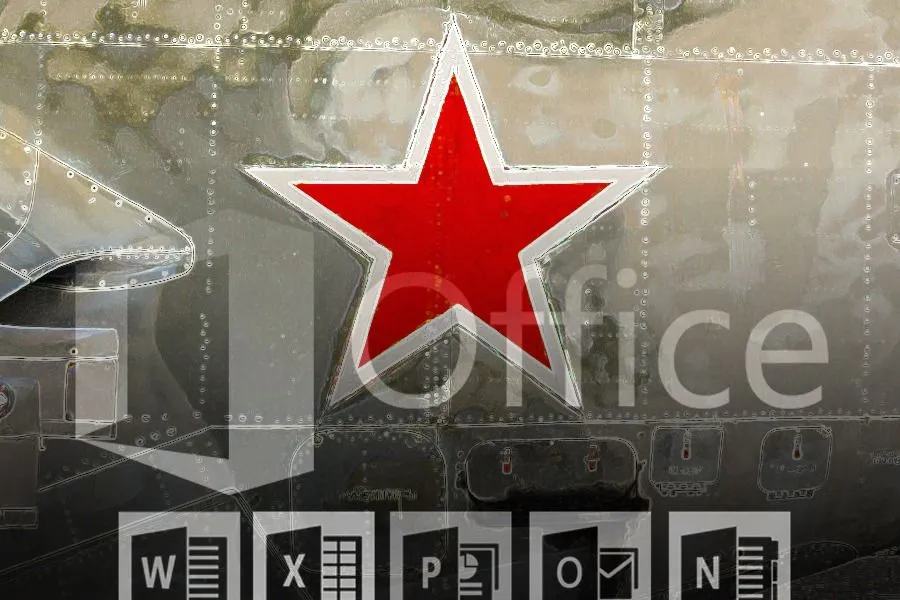Running for Office: Russian APT Toolkits Revealed
Analysis Summary
- Russian APTs regularly target Microsoft products with 55% of exploited vulnerabilities targeting versions of Office, Windows, and Internet Explorer products. Targeting widely adopted software provides the path of least resistance for a state-sponsored actor.
- Microsoft Office vulnerability targeting is in line with heavy use of spear phishing by Russian actors including APT28. Decoy (lure) attachments are often Excel files or Word documents.
- APT28, associated by many with Russian military intelligence (GRU), has 22 known exploited vulnerabilities in its toolkit. Seven of these vulnerabilities have no available public exploit.
- APT29, associated by many with the Russian Federal Security Service (FSB), utilizes five known exploited vulnerabilities with no vulnerability overlap with APT28.
- 73% of vulnerabilities targeted by Russian APTs have available public exploits posted to various corners of the web including Metasploit, Exploit Database, and GitHub.
- 46% of known Russian APT exploited vulnerabilities are also found in exploit kits used by cyber criminals.
Editor’s Note: Recorded Future would like to correct the listing of vulnerabilities tied to Russian APTs based on great feedback from a reader. CVE-2014-3897 is incorrectly linked to Strontium (APT28). This is a typo of Microsoft Internet Explorer vulnerability CVE-2013-3897 originally made in a chart on Page 8 of 2015 Microsoft Security Intelligence Report on APT28 — and copied by other researchers on the web. No changes have been made to the stats derived below, however this brings the overall tally to 32 associated vulnerabilities as of this posting.
Recorded Future analysis of Russian hacking collectives has highlighted 33 known exploited product vulnerabilities used by various groups to steal information or compromise victim computers. 27 of these are tied to APT28 and APT29, collectives known by many names and possibly associated with Russian military intelligence (GRU) and the Federal Security Service (FSB) respectively.
Recent attacks and alleged subsequent leaks of stolen information from the Democratic National Committee (DNC) have highlighted the unprecedented impact of Russian threat actors in the 2016 United States Presidential election. In June 2016, Crowdstrike identified APT28 and APT29’s presence in the DNC’s computer systems. APT28 gained access in April 2016, while APT29 gained access in summer 2015.
These actors, as well as alleged Russian state-sponsored groups Energetic Bear and Turla, regularly exploit multiple products in the Microsoft family (Office, Internet Explorer, and Windows). This is likely due to their massive user base and — in the case of Office — association with email attachment-based attacks. 55% of known leveraged vulnerabilities belong to the Microsoft family.
Interestingly, only 46% of the known exploited vulnerabilities were seen in cyber criminal-focused exploit kits. 73% of the known exploited vulnerabilities had public exploits available on forums, blogs, paste sites, and code repositories such as Exploit Database, Metasploit, and GitHub.
This suggests some element of unique capability. For instance, APT28 utilizes seven exploited vulnerabilities for which there are no available public exploits. However, in the case of Energetic Bear, public exploits make up its entire toolkit according to Kaspersky research and the below table.
Methodology
This analysis focused on advanced persistent threats (APTs) and malware families tied to likely Russian state sponsor. Recorded Future analyzed web sources including blogs, forums, paste sites, code/malware repositories, social media, and posted PDFs of finished reports and presentations.
This approach is akin to a meta-analysis.
No original analysis of malware samples was conducted. The goal of this analysis was to highlight broad trends and tactics employed by Russian threat actors.
Attack attribution and identifying threat actor plans and intentions are the hardest problems in intelligence analysis. Recorded Future makes no specific claims to recent and high-profile attacks against United States presidential candidates or campaigns.
Scope
Using Recorded Future, we analyzed information published to the web linking Russian APTs to exploited vulnerabilities from January 1, 2012 to July 31, 2016.
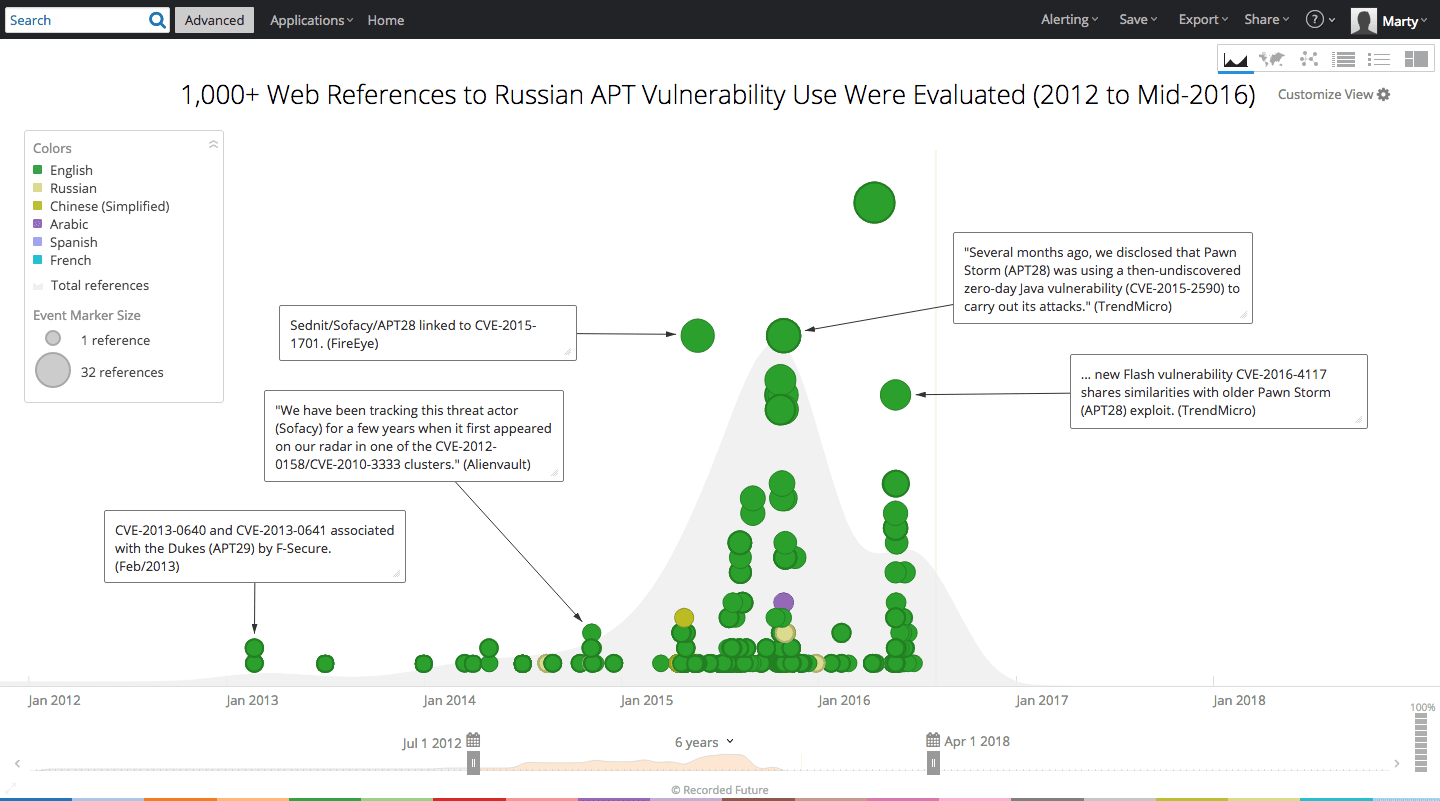
Subsequent analysis was conducted, applying the list of 33 known exploited vulnerabilities against Recorded Future holdings of available exploits and exploit kits frequented by cyber criminals and generally available for sale on deep and dark web (onion) forums.
As noted in previous Recorded Future APT research, analysis is complicated by the wide variety of branding and codewords applied to different facets of the problem. Some are grouped by signatures, some by actors, others by tools. Recorded Future ontologies and Threat Actor Intelligence Cards™ supported this analysis which focused on the following four Russian-linked APTs/malware families:
- APT28 AKA Fancy Bear, Operation Pawn Storm, Strontium, Sednit, Sofacy, Tsar Team. Possibly associated with the Russian military’s Main Intelligence Department or GRU (Главное Разведывательное Управление).
- APT29 AKA Cozy Bear, The Dukes, Office Monkeys. Possibly associated with Russia’s primary intelligence service the Federal Security Service or FSB (Федеральная служба безопасности Российской Федерации), the successor to the KGB.
- Energetic Bear AKA Crouching Yeti, Dragonfly, Group 24, Koala Team. Associated with Havex malware.
- Turla AKA Epic Turla, Snake, Ouroboros, Carbon. Possibly associated to Agent.BTZ campaign.
While not covered in this report, APT28, APT29, Energetic Bear, and Turla all target information consistent with Russian intelligence goals of collection on strategic adversaries, neighbors, energy targets, etc. Links to excellent research from FireEye, TrendMicro, Kaspersky, Microsoft, Crowdstrike, etc. are provided as appropriate.
Results
The following products were regularly targeted by the four Russian groups:
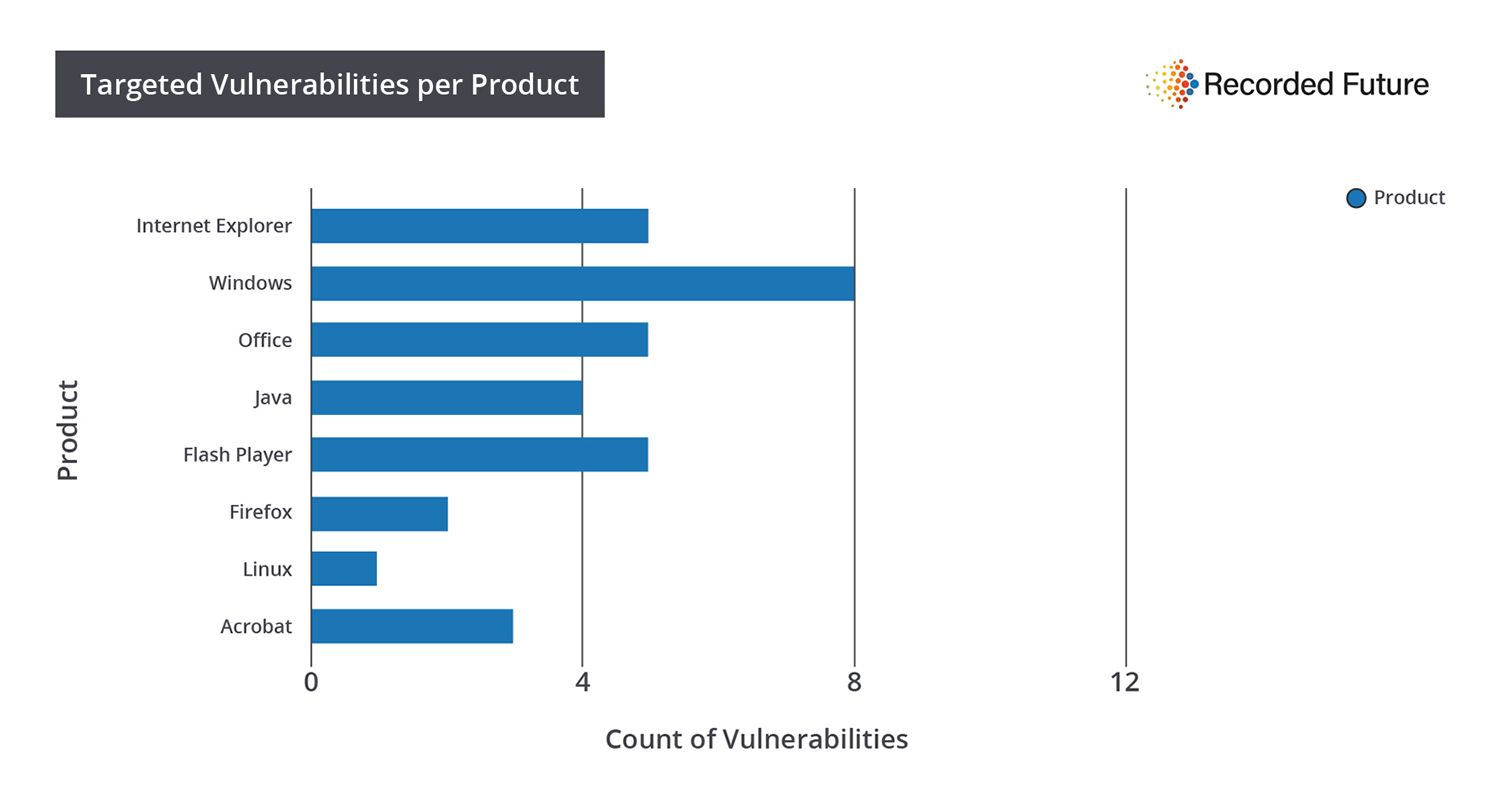
Organized by company:
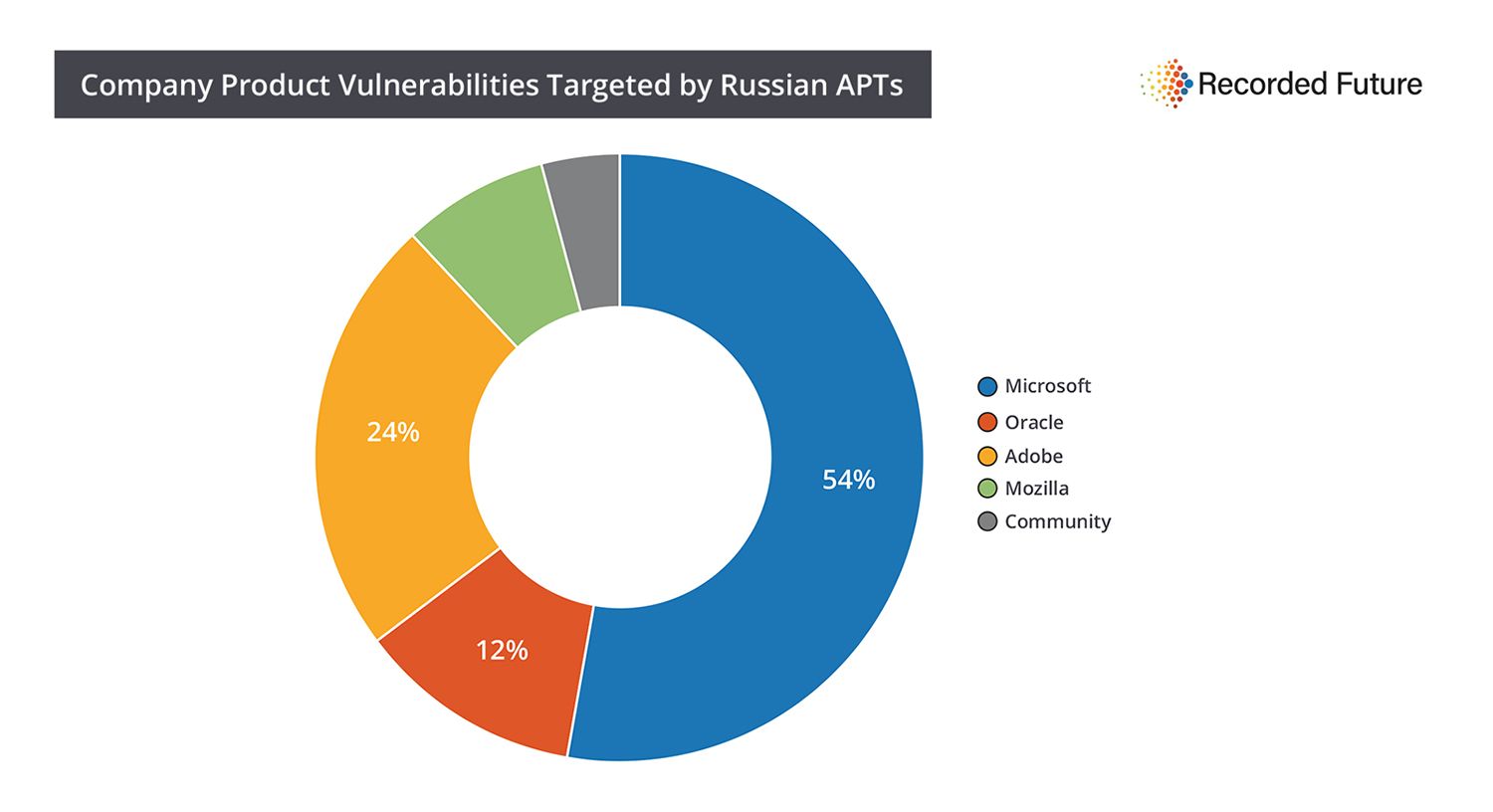
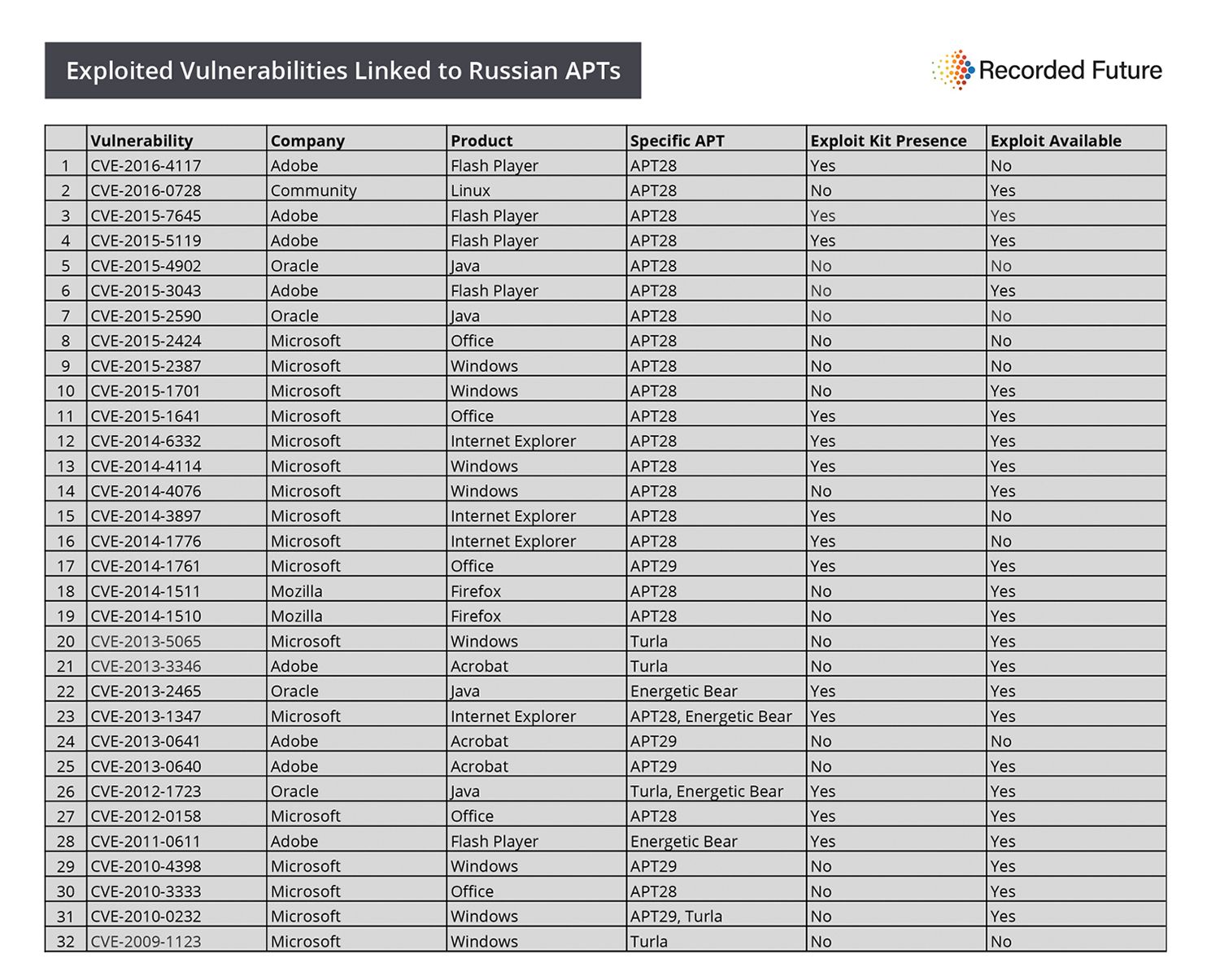
Use of the Identified Vulnerabilities
Russian APTs employ tactics similar to other cyber threat actors including targeted spear-phishing, spoofed domains supporting credential phishing, social engineering, and watering-hole attacks.
Heavy Russian APT use of Office and Adobe PDF exploits may be in line with the more targeted nature of state-sponsored attacks. Criminal campaigns such as ransomware play a numbers game, while state-sponsored attacks focus on specific organizations and information.
Previous Recorded Future analysis highlighted heavy use of Adobe Flash Player exploits in criminal exploit kits. Comparatively, five of the 33 identified vulnerabilities impacted Flash Player. Eight of the 33 impacted Office/Acrobat (generally email attachment exploits).
Siloed Approaches
Recorded Future analysis of exploited vulnerabilities used by APT28 and APT29 revealed no known overlapping use of vulnerabilities. This lends credence to the theory put forth by multiple experts that the two groups — possibly associated with GRU and FSB — don’t coordinate or share resources and infrastructure. Interestingly, according to Crowdstrike, the two groups unwittingly stole the same set of DNC credentials.
Products targeted, grouped by APT:
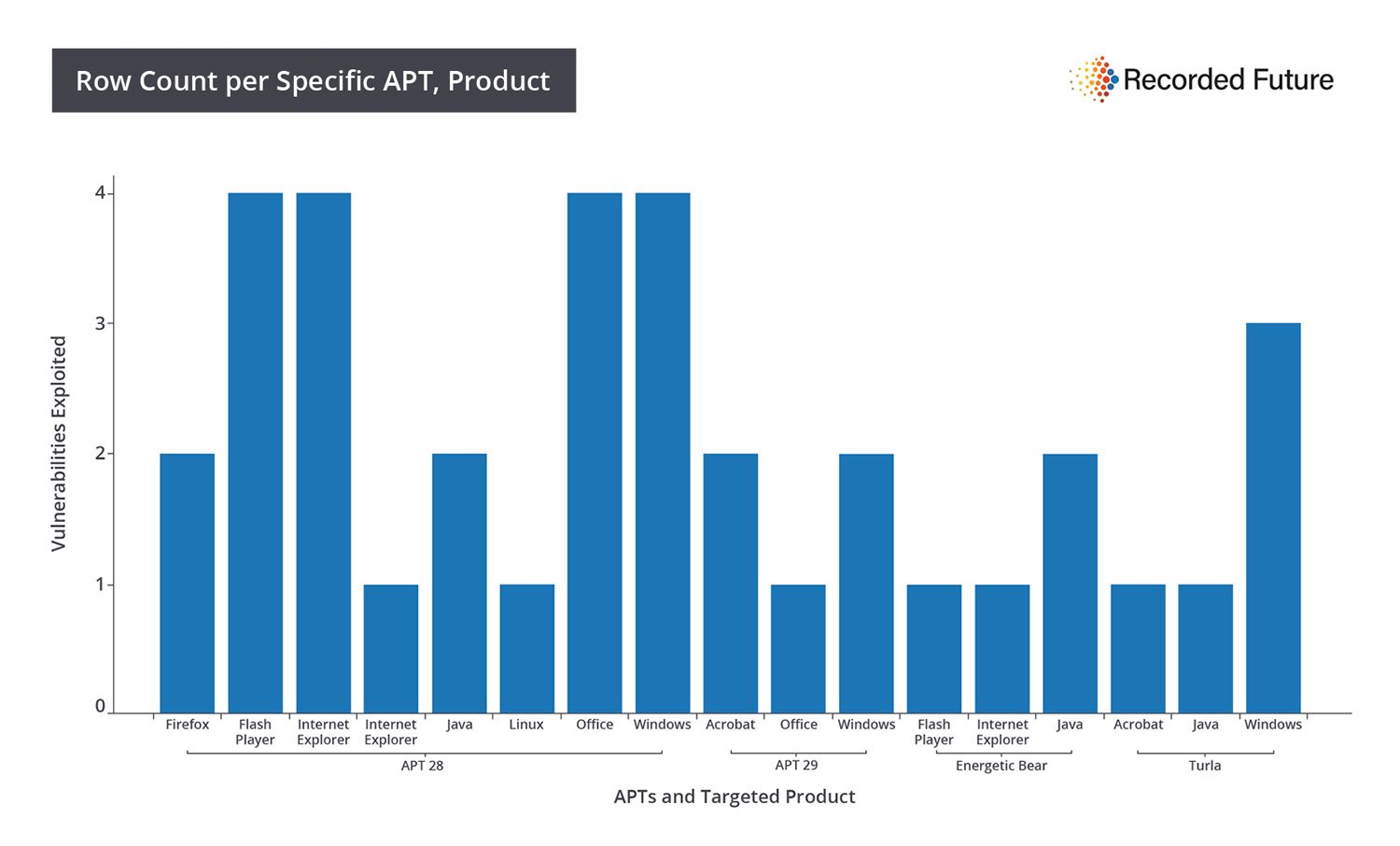
Overlap With Exploit Kits
46% of known Russian APT exploited vulnerabilities are also found in exploit kits used by cyber criminals. Exploit kits are available for purchase or rent on deep and dark web (onion) forums for cyber criminals seeking to deploy payloads including ransomware.
Targeted vendor, grouped by APT (colored by vulnerability present in exploit kit):
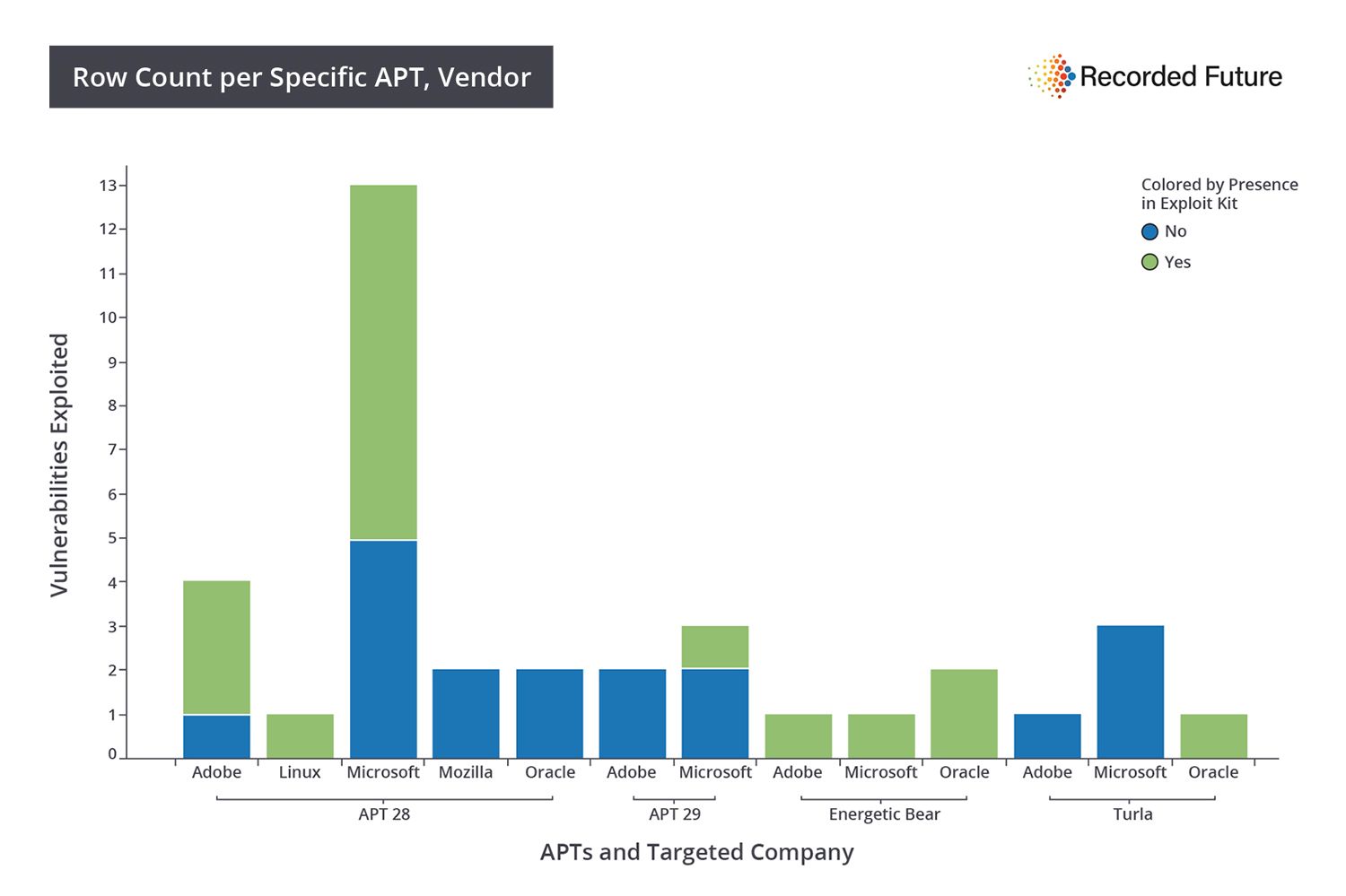
Many exploits (73%) are publicly available for these identified vulnerabilities, although the date of the publication of these exploits (versus the date of the attack) is hard to determine. Regardless, the use of common or public exploits serves a variety of purposes:
- Popular products (Windows, Office, Internet Explorer) are more likely to have well-known (and sometimes publicly available) exploits.
- Targeting popular products supports a “play the odds” approach to successful exploitation of installed software on a target computer.
- Popular product exploits help cloud efforts at attribution.
Targeted vendor, grouped by APT (colored by public availability of exploit):
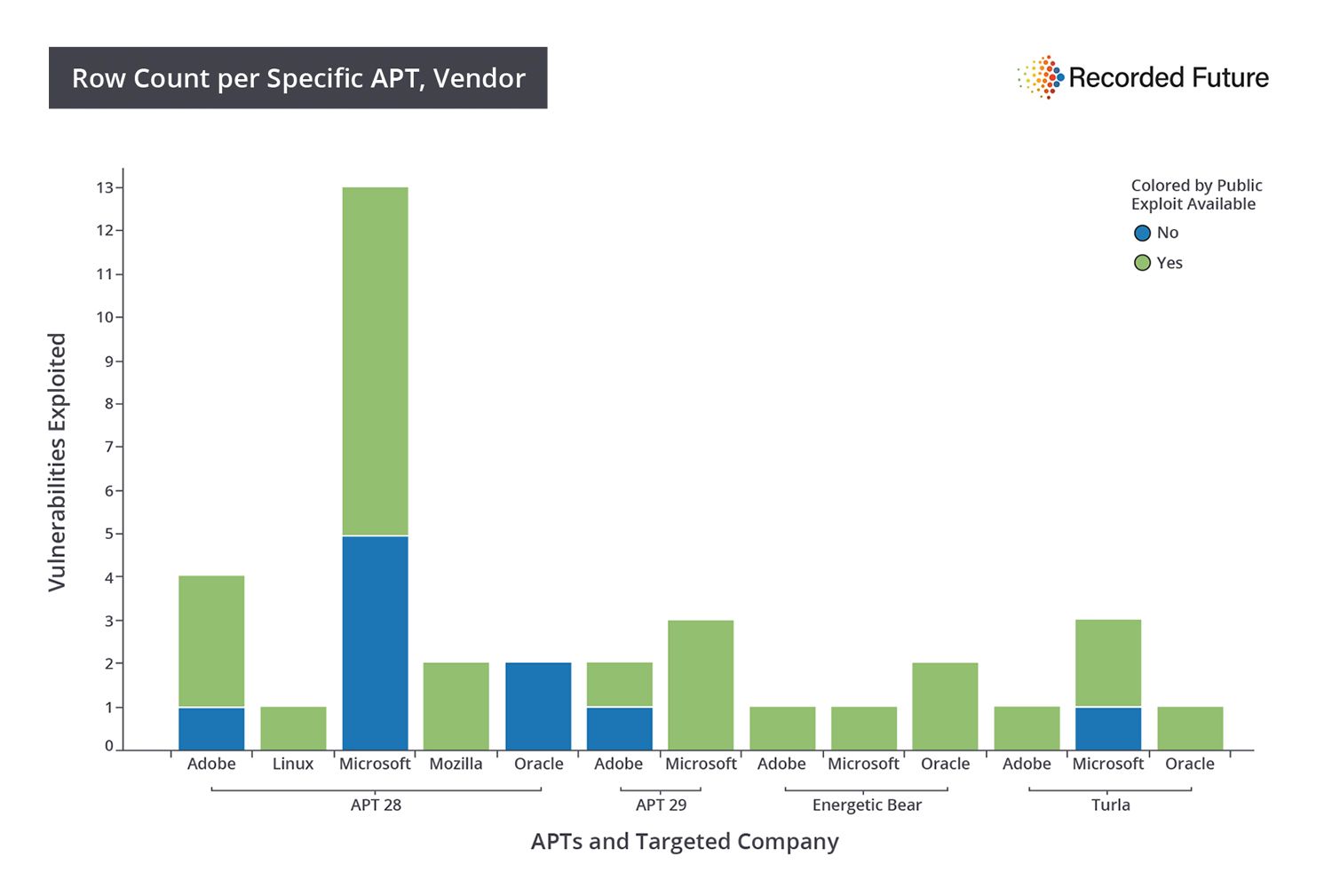
Impact
With 1.5 billion people using Windows every day, and 1.2 billion people with Office products installed on their machines, the “play the odds” approach begins to explain the popularity of Microsoft products with Russian APTs.
Popular Java (used by 89% of U.S. computers) and Adobe (50 billion PDFs opened in Adobe in 2015) exploits follow this pattern. Much like with cyber criminals, the path of least resistance to a successful redirection or implant is often the best for a state-sponsored actor targeting strategic information.
Recommended Actions
We recommend you:
- Patch all vulnerabilities identified in this post.
- Conduct enterprise web and email security awareness training.
- Utilize two-factor authentication and VPNs where appropriate.
- Enforce segregation of user account privileges.
- Enable “click to play” for Adobe Flash Player in web browsers.
- Consider alternative PDF viewers.
- Monitor the web for posted email addresses (even those without paired passwords).
Related News & Research



